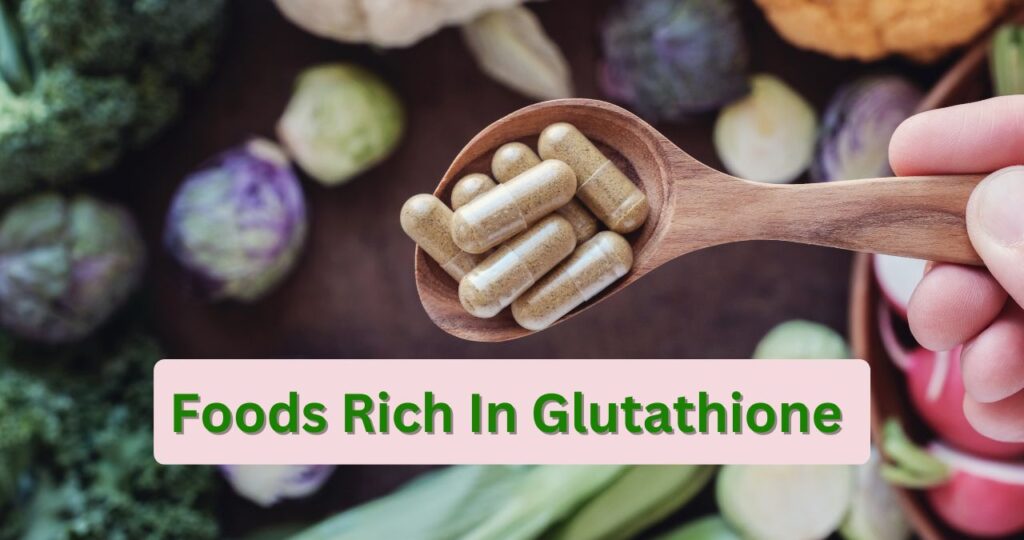
For good reason, antioxidants are currently in the spotlight in the arena of health and wellness. Free radicals, which can induce oxidative stress and result in a number of health problems, are mostly neutralized by these potent substances. One of the body’s most powerful antioxidants [1] is glutathione, sometimes known as the “master antioxidant.” Learn about the definition, advantages, and foods that contain glutathione to increase your body’s supply of this essential molecule in this blog post.
What is Glutathione?
Glutathione is a tripeptide, a small molecule composed of three amino acids: glutamine, cysteine, and glycine. It is naturally produced by our bodies and is found in nearly every cell, but its levels can decrease due to factors such as aging, stress, and exposure to toxins and pollutants.
Glutathione’s primary function is to act as an antioxidant, neutralizing free radicals and reactive oxygen species that can damage cells and contribute to the development of various diseases. It also plays a crucial role in detoxification processes, helping to remove harmful compounds from the body.
Benefits of Glutathione
Maintaining optimal levels of glutathione has been linked to numerous health benefits, including:
- Boosting Immune Function: Glutathione supports the proper functioning of the immune system, helping the body fight off infections and diseases.
- Reducing Oxidative Stress: As a powerful antioxidant, glutathione helps protect cells from damage caused by free radicals, which can contribute to chronic diseases like cancer, heart disease, and neurodegenerative disorders.
- Supporting Detoxification: Glutathione plays a key role in the body’s detoxification processes, helping to eliminate toxins, pollutants, and metabolic waste products.
- Promoting Healthy Skin: Glutathione’s antioxidant properties can help protect the skin from damage caused by UV radiation and environmental pollutants, potentially reducing the signs of aging and improving skin health.
- Enhancing Energy Levels: Glutathione is involved in the production of energy in cells, and maintaining adequate levels may help combat fatigue and improve overall energy levels.
Dietary Sources of Glutathione
While our bodies produce glutathione, certain dietary sources can help boost its levels. Here are some of the best foods rich in glutathione or its precursors:
1. Cruciferous Vegetables
Cruciferous vegetables, such as broccoli, cauliflower, kale, and Brussels sprouts, are excellent sources of glutathione. These nutrient-dense veggies are also rich in other antioxidants and phytochemicals that support overall health.
2. Allium Vegetables
Garlic, onions, and shallots belong to the allium family and are excellent sources of sulfur-containing compounds that can help boost glutathione production in the body.
3. Avocados
Avocados are not only a delicious and versatile fruit, but they are also a rich source of glutathione precursors, particularly cysteine.
4. Nuts and Seeds
Many nuts and seeds, such as walnuts, almonds, and chia seeds, are rich in glutathione-boosting compounds, including cysteine and selenium.
5. Whey Protein
Whey protein, a by-product of cheese production, is a good source of cysteine and can help increase glutathione levels when consumed as a dietary supplement or in protein-rich foods like yogurt and kefir.
6. Spinach
Spinach is a nutrient-dense leafy green packed with various antioxidants, including glutathione and its precursor amino acids.
7. Asparagus
Asparagus is not only a delicious and versatile vegetable but also a good source of glutathione and other antioxidants.
8. Tomatoes
Tomatoes are rich in various antioxidants, including glutathione, and are a staple in many cuisines around the world.
9. Curcumin
Curcumin, the active compound found in turmeric, has been shown to help boost glutathione levels in the body by increasing its production and reducing its depletion.
10. Green Tea
Green tea is a rich source of antioxidants, including polyphenols like epigallocatechin gallate (EGCG), which can help increase glutathione levels and protect cells from oxidative stress.
Incorporating Glutathione-Rich Foods into Your Diet
To reap the benefits of glutathione, it’s essential to incorporate a variety of the aforementioned foods into your diet. Here are some tips:
- Aim for a plant-based diet rich in fruits, vegetables, nuts, and seeds to ensure an adequate intake of glutathione precursors and other antioxidants.
- Include cruciferous vegetables, such as broccoli and kale, in your meals several times a week.
- Add garlic, onions, and shallots to your cooking for a flavor boost and a glutathione kick.
- Snack on avocados or incorporate them into smoothies, salads, or dips.
- Sprinkle nuts and seeds over your meals or enjoy them as a nutrient-dense snack.
- Consider incorporating whey protein powder or yogurt into your diet for an additional source of cysteine.
- Experiment with different recipes featuring spinach, asparagus, and tomatoes to increase your intake of glutathione-rich foods.
- Add turmeric or curcumin supplements to your routine for an extra glutathione boost.
- Enjoy a cup of green tea daily for its antioxidant properties and potential to support glutathione levels.
To prevent glutathione deficiency and support general health and well-being, keep in mind that a varied, balanced diet rich in whole, nutrient-dense foods is essential.
Conclusion
Glutathione, a powerful antioxidant, enhances immune system and supports detoxification processes। Although our bodies naturally produce glutathione, incorporating foods rich in glutathione into our diets can help maintain optimal levels and support overall well-being। You can reduce your risk of many chronic diseases by following a plant-based, antioxidant-rich diet that includes foods like cruciferous vegetables, alliums, avocados, nuts, and seeds।

Lifebing is driven by an unrelenting passion for promoting health and well-being, our team is wholly committed to curating exceptional content and immersive experiences.
